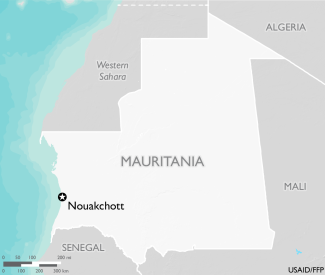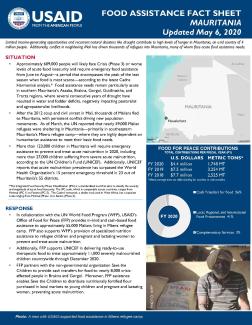May 6, 2020
Limited income-generating opportunities and recurrent natural disasters like drought contribute to high levels of hunger in Mauritania, an arid country of 4 million people. Additionally, conflict in neighboring Mali has driven thousands of refugees into Mauritania, many of whom face acute food assistance needs.
Situation
- Approximately 609,000 people will likely face Crisis (Phase 3) or worse levels of acute food insecurity and require emergency food assistance from June to August—a period that encompasses the peak of the lean season when food is most scarce—according to the latest Cadre Harmonisé* analysis. Food assistance needs remain particularly acute in southern Mauritania’s Trarza, Brakna, Gorgol, Guidimakha and Assaba regions, where several consecutive years of drought have resulted in water and fodder deficits, negatively impacting pastoralist and agropastoralist livelihoods.
- After the 2012 coup and civil unrest in Mali, thousands of Malians fled to Mauritania, with persistent conflict driving new population movements. As of March, the UN reported that nearly 59,000 Malian refugees were sheltering in Mauritania—primarily in southeastern Mauritania’s Mbera refugee camp—where they are highly dependent on humanitarian assistance to meet their basic food needs.
- More than 123,000 children in Mauritania will require emergency assistance to prevent and treat acute malnutrition in 2020, including more than 27,000 children suffering from severe acute malnutrition, according to the UN Children’s Fund (UNICEF). Additionally, UNICEF reports that acute malnutrition prevalence has surpassed the World Health Organization’s 15 percent emergency threshold in 23 out of Mauritania’s 55 districts.
*The CH is a standardized tool used across West Africa that aims to classify the severity and magnitude of acute food insecurity. The CH scale, which is comparable across countries in West Africa, ranges from Minimal (Phase I) to Famine (Phase 5).
Response
- In collaboration with the UN World Food Program (WFP), USAID’s Office of Food for Peace (FFP) provides in-kind and cash-based food assistance to approximately 55,000 Malians living in Mbera refugee camp. FFP also supports WFP’s provision of specialized nutrition assistance to refugee children and pregnant and lactating women to prevent and treat acute malnutrition.
- Additionally, FFP supports UNICEF in delivering ready-to-use therapeutic food to treat approximately 11,000 severely malnourished children countrywide through December 2020.
- FFP partners with the non-governmental organization Save the Children to provide cash transfers for food to nearly 8,000 crisis-affected people in Brakna and Gorgol. Moreover, FFP assistance enables Save the Children to distribute nutritionally fortified flour purchased in local markets to young children and pregnant and lactating women, preventing acute malnutrition.
Food for Peace Contributions
Total Contributions:
| U.S. Dollars | Metric Tons | |
|---|---|---|
| Fiscal Year 2020 | $4.4 million | 1,748 MT |
| Fiscal Year 2019 | $7.5 million | 3,254 MT |
| Fiscal Year 2018 | $7.7 million | 2,525 MT |
* Metric tonnage does not reflect funding for vouchers or cash transfers.
Image

(160.55 KB)

